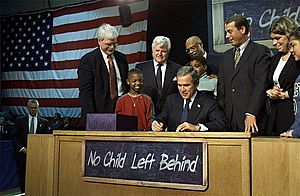No Child Left Behind Act facts for kids
The No Child Left Behind Act was an important United States law. It aimed to help all students in American schools get a good education. This law was signed by President George W. Bush on January 8, 2002. It set new rules for schools across the country.
Contents
The No Child Left Behind Act
What Was This Law About?
The No Child Left Behind Act wanted to make sure every student reached high learning standards. It was designed to improve schools and help students who might be struggling. The law said that by the 2013-2014 school year, all students should be at a "proficient" level in their studies. This means they should understand subjects well, like getting a B+ or higher.
How Did It Affect Schools?
This law required schools across the United States to test their students regularly. These tests helped to see if students were learning enough. If schools did not meet the goals set by the law, they could lose money from the federal government. The law also included rules for students who spoke different languages. It wanted to make sure these students also reached the same high standards.
Money for Schools
After the No Child Left Behind Act started, the United States Congress gave more money to schools. In 2001, schools received about $42.2 billion. By 2007, this amount increased to $54.4 billion. The funding specifically for the No Child Left Behind programs also grew a lot. It went from $17.4 billion in 2001 to $24.4 billion. Money for reading programs saw a big increase too. It quadrupled from $286 million in 2001 to $1.2 billion. This extra money was meant to help schools meet the new goals and improve education for all students.
See also
- In Spanish: Que Ningún Niño Se Quede Atrás para niños


